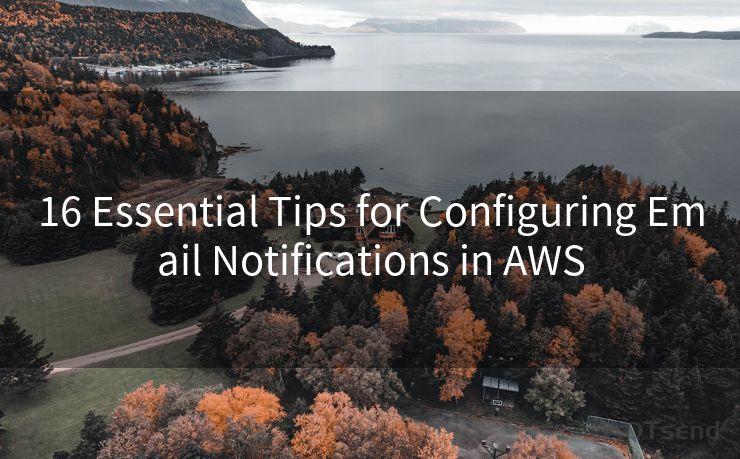16 Essential Tips for Configuring Email Notifications in AWS




When it comes to managing your resources and services on Amazon Web Services (AWS), staying informed about important events, alarms, or changes to your infrastructure is crucial. Email notifications provide a convenient way to stay up-to-date, even when you're not actively monitoring the AWS Management Console. Here are 16 essential tips for configuring email notifications in AWS to ensure you never miss a critical update.
1. Understand AWS Notification Services
Before diving into the configuration, it's essential to understand the various AWS services that offer notification capabilities, such as Amazon CloudWatch, AWS CloudTrail, and Amazon Simple Notification Service (SNS).
2. Set Up an SNS Topic
Create an SNS topic specifically for email notifications. This topic will serve as a central hub for sending and receiving messages about important events in your AWS environment.
3. Configure SNS to Send Emails
Within your SNS topic settings, enable email notifications by specifying the email addresses that should receive the alerts. Ensure that the email addresses are valid and can receive external emails.
4. Utilize CloudWatch Alarms
Set up CloudWatch alarms to monitor key metrics like CPU utilization, network traffic, or disk space. When these metrics cross a certain threshold, configure the alarms to trigger a notification to your SNS topic.
5. Integrate with CloudTrail
AWS CloudTrail tracks API calls made in your AWS account. By integrating CloudTrail with SNS, you can receive email notifications when specific API activities occur, such as creating or deleting resources.
6. Filter Notifications
To avoid information overload, use SNS's message filtering feature. This allows you to specify criteria for when an email notification should be sent, based on the content of the message.
7. Customize Email Templates
Personalize the email notifications you receive by creating custom email templates. This helps in quickly identifying the nature of the alert and taking appropriate action.
8. Test Your Notifications
Regularly test your notification system by triggering mock alarms or events. This ensures that everything is working as expected and that you're receiving notifications promptly.
9. Monitor Delivery Status
Keep track of the delivery status of your email notifications. SNS provides delivery status notifications, allowing you to identify any issues with email deliverability.
10. Use Dedicated Email Services
For more advanced email handling, consider integrating with third-party email services like Amazon Simple Email Service (SES). This can provide additional features like email authentication, tracking, and bounce handling.
11. Secure Your Email Communications
Ensure that your email communications are secure by enabling encryption. Both SNS and SES support various encryption methods to protect your data in transit and at rest.
🔔🔔🔔
【AOTsend Email API】:AOTsend is a Managed Email Service for sending transactional emails. Support Email Types: reminders, authentication, confirmations, notifications, verification codes, invoices, password resets, account activations, billing statements, two-factor authentication (2FA), and one-time passwords (OTP) emails, etc. $0.28 per 1000 Emails. 99% Delivery, 98% Inbox Rate.
You might be interested in:
Why did we start the AOTsend project, Brand Story?
What is a Managed Email API, How it Works?
Best 25+ Email Marketing Platforms (Authority,Keywords&Traffic Comparison)
Best 24+ Email Marketing Service (Price, Pros&Cons Comparison)
Email APIs vs SMTP: How they Works, Any Difference?

12. Automate Responses
Utilize AWS Lambda functions to automate responses to specific notifications. For example, you could set up a Lambda function to automatically scale your EC2 instances based on a CloudWatch alarm notification.
13. Archive Important Notifications
Set up a system to archive important notifications for future reference. This could be as simple as forwarding emails to a dedicated email account or using a more advanced logging and monitoring solution.
14. Regularly Review and Update
Periodically review your notification settings to ensure they still meet your needs. As your AWS environment evolves, so should your notification strategy.
15. Leverage IAM for Access Control
Use AWS Identity and Access Management (IAM) to control who can receive and manage email notifications. This adds another layer of security to your notification system.
16. Monitor SNS Costs
Keep an eye on your SNS costs, as frequent email notifications can quickly add up. AWS provides detailed billing reports to help you track and manage your expenses.
By following these 16 essential tips, you can effectively configure email notifications in AWS to stay informed and proactive in managing your cloud environment. Remember to regularly review and update your settings as your AWS usage and needs change.




Scan the QR code to access on your mobile device.
Copyright notice: This article is published by AotSend. Reproduction requires attribution.
Article Link:https://www.mailwot.com/p5255.html



